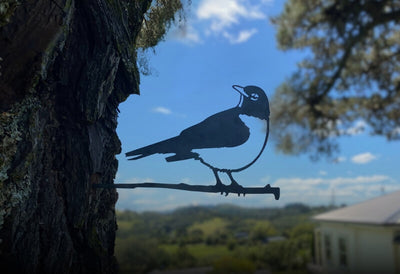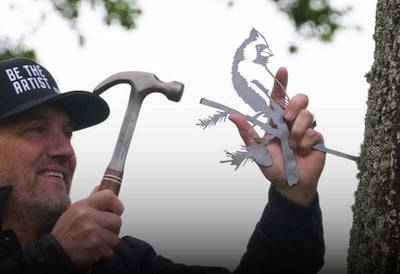When you hammer a Metalbird into your garden, you’re doing more than just decorating.
You’re joining something.
Something bigger than you, bigger than us.
A global flock. A creative movement. A collective of people who believe in small acts of art that change the way we see the world.
It’s not about trends or status symbols. It’s about belonging to a tribe of people who look up, not down.
People who believe a patinaed bird silhouette in the backyard is just as important as a painting in a gallery.
People who think art shouldn’t be locked behind glass.
The World’s Largest Outdoor Art Project
We didn’t plan it this way.
When I cut the first Metalbird out of steel and hammered it onto a lamppost in Grey Lynn, Auckland, I wasn’t thinking about starting the world’s largest outdoor art project.
I just wanted to make people look up. Pause for a second. See something beautiful in a place they didn’t expect.
But then it took off.
First in New Zealand. Then Australia. Then the US, Canada, the UK, Europe. Now there are hundreds of thousands of Metalbirds installed in gardens, parks, laneways, and public spaces around the world.
Each one installed by hand. Each one part of the same invisible thread.
Why It Matters
Art isn’t just for galleries. It’s for everyday life.
A Metalbird in the garden is art that lives outdoors. It patinas in the rain. It catches shadows in the evening. It stands quietly in the corner while kids grow up, dogs bark, and dinners get cooked.
It’s not precious. It’s not untouchable.
It’s part of the daily landscape.
And that’s the point.
Because when art becomes part of life, it starts conversations.
Someone comes over for a cuppa, spots the bird, and says, “What’s that?”
Suddenly you’re talking about birds, memory, grief, new beginnings, or just the fact that it looks bloody good against the sky.
That’s not decoration. That’s connection.
Who’s in the Collective?
The Metalbird collective isn’t made up of art snobs or design purists. It’s people like you:
-
The grandmother who installs a Robin in the rose garden because it reminds her of her husband.
-
The bloke who hammers a Kingfisher onto the jetty at the bach because his dad loved fishing there.
-
The teenager who sticks a Fantail in the school veggie patch because it looks cool and makes people smile.
-
The couple who send a pair of Hummingbirds to friends overseas, so they have a piece of home in a new place.
It’s a global tribe of quiet disruptors... people who believe small, beautiful things can make the world a bit better.
Why Patina Is Part of the Story
We use Corten steel on purpose.
It patinas. It changes. It settles into the landscape. It’s not about staying shiny or perfect. It’s about weathering with time, while the protective surface locks in place to shield the bird for decades.
When you hammer in your bird, you’re making a mark that lasts but doesn’t stay static. It shifts with the seasons. It ages gracefully. It belongs to the place you put it.
That’s what makes this project different from other art.
It’s not about preservation. It’s about participation.
How This Became a Movement
We didn’t set out to start a movement. But one thing led to another.
People started sharing photos of their installations. Backyards, balconies, memorial gardens, front fences.
They started telling stories. About why they chose the Robin, or the Cardinal, or the Tūī. About who they were remembering. About what they were celebrating.
Then people in other countries saw those stories and thought, “I want to do that too.”
Before long, it wasn’t just a few birds in Auckland. It was thousands of installations across six continents.
A kind of quiet, creative rebellion against throwaway culture and fast design.
The Power of Small Acts
We live in a world that tells us big change needs big gestures.
But sometimes it’s the small acts that ripple out the furthest.
Installing a bird in your backyard might not feel like activism. But in a way, it is.
You’re saying:
-
Art belongs in everyday life.
-
Nature deserves attention.
-
Memory should be marked.
-
Love should have a place to land.
That’s not small. That’s huge.
What Happens When You Join
When you put a Metalbird in the ground, you become part of the collective whether you realise it or not.
There’s no secret handshake. No membership fee. No fancy club newsletter (unless you count the emails we send when we’ve got a new bird out).
But you’re still part of it.
You’re part of a global art installation that grows every day. One silhouette at a time. One garden at a time.
Why We’re Proudly Local... And Global
We make our birds locally, wherever we can.
In New Zealand and Australia, we cut from NZ and Aussie steel.
In the US, it’s American-made.
In the UK and Europe, it’s local too.
We do that because this project isn’t about shipping stuff across the world for no reason. It’s about embedding art into place.
When you install a bird in your backyard, you’re adding to a global project... but you’re also making something personal, regional, and real.
What’s Next?
This project doesn’t have an end point.
We’re not aiming for a world record (though maybe we’ve already broken one, who knows). We’re aiming for connection.
More backyards with birds.
More people looking up.
More conversations started by something small and beautifully patinaed on a fence post.
If that sounds like something you want to be part of, you’re in.
Join the Flock
If you’re ready to add your bird to the world’s largest outdoor art project, we’d love to have you.
Pick the bird that speaks to you. Install it wherever feels right. Take a photo. Tell your story.
And know you’re part of something bigger than just you.
Find your bird here.
Suggested Image:
A collage of Metalbird installations from around the world... rooftops in Amsterdam, backyards in Auckland, balconies in Sydney, gardens in Chicago. Different light, different seasons, but the same silhouette shapes. A visual map of the global flock.



